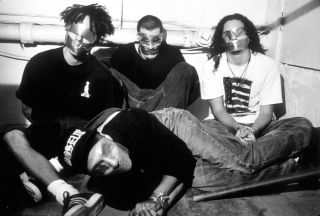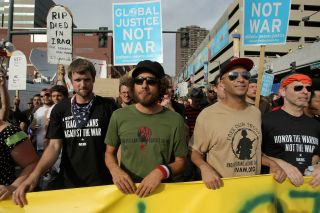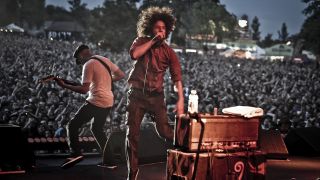Jesus, has it really been 20 years since Rage Against The Machine released their eponymous debut album? Twenty years since the Queen’s “annus horribilis”. Twenty years since the Rodney King beating sparked the LA riots. Twenty years since the IRA tried to bomb Downing Street. Some of our younger readers weren’t even born then so have no idea what we’re blathering about, but you can look it up if you feel so inclined. There’s a thing called the Internet now that wasn’t around 20 years ago.
These were interesting times, ladies and gents, not least for rock’n’roll: having survived 80s hair metal with grunge as a remedy if not a cure, the early 90s saw a cross pollination of genres like never before with a bubbling cauldron of sounds from the underground. Well, up to a point. For most there was still a mutual mistrust: rap came with a silent C, punk was two years from away from breaking (again), and metal had a legacy of stupidity and eyeliner. And then, in 1992, along came Rage Against The Machine breaking all the rules with a collision of styles that took in everything from The Clash and The Beastie Boys and Public Enemy to Led Zep and Black Sabbath. And maybe some funk.

“We harboured no anticipation of success given the fact that the music was a combination of genres that were at war with each other – punk, metal, and hip hop,” laughs guitarist Tom Morello. “And it was an interracial band, which was never heard on the radio, certainly in rock. Then there was the political content of the songs, which was well to the left of bands like The Clash and Public Enemy. Prior to 1992 that was not a recipe for getting to the top of the charts. Our expectations were very humble. When we were writing the songs for the first record we really didn’t even think we’d be able to book a club gig. We never dreamed of a record deal or a tour, we just thought the music was so beyond what was acceptable.”
Indeed. 1992 may have also seen Ice T’s Bodycount release Cop Killer and Sinead O’Connor effectively destroy her career by tearing up a picture of the Pope on Saturday Night Live, but Rage were something entirely different, a musical Molotov cocktail that was backed by activism not seen since the likes of Crass and Conflict. Certainly never seen in the mainstream. And then there was the cover art featuring a picture of a Buddhist monk named Thích Quáng Đúc meditating as he burned himself to death in protest against the South Vietnamese government.
“Yeah, one more reason we thought people would never hear the record!” says Tom. “The idea in the music was that it was going to be an uncompromised and uncompromising expression of our world views as musicians and as activists. The photo on the cover of the monk self- immolating for his beliefs was one that we thought captured the integrity and the power that we were striving for in our songs!”
Despite their best efforts, Rage went straight into the charts. Hell, we’ve always loved a bit of anarchy in the UK. The first single, Killing In The Name, even made the top 40, leading to a huge controversy when Radio One DJ Bruno Brookes accidentally played the uncensored version in the top 40 countdown. As Tom puts it: “The entire country was treated to 16 ‘fuck you I won’t do what you tell me’s and one ‘motherfucker’.”
“The first country where Rage broke big was the UK and it was in part due to that Sex Pistols moment on the radio,” laughs Tom. “That caused the kind of uproar that the UK press loves and there was a brief moment when we were like a teen sensation in the UK! There was a lot of kids sleeping in the lobbies of the hotels!”
In fairness, it’s the only song on the album not to have printed lyrics.
“Well my memory of it is that if you printed out the lyrics then it reads somewhat less like poetry,” chuckles Tom. “It’s basically four lines and then a whole lot of ‘fuck you’s!”
Aside from the ‘fuck you’s, Rage also shone an angry light on some serious and controversial issues, not least the plight of Native American activist Leonard Peltier who was unfairly convicted of shooting two FBI agents in 1977. The video for Freedom tells his story.
“And there was an interesting circumstance behind that,” explains Tom. “Because throughout Europe, South America and Asia the band had started to explode, partly because you have less censorship there, so Killing In The Name and Bullet In The Head were heard in their entirety in some format. But not in the US because we refused to edit for lyric content. We were still opening in clubs for House Of Pain [in the US] and playing big festivals around the rest of the world, to the great embarrassment of the US record company. So it was actually at their suggestion that the next single be a six-and-a-half-minute song without a chorus, and that we make a video for Leonard Peltier! That suggestion came from the record company, not the band, like they were trying to outflank us!”
Or sell rebellion?
“Exactly,” says Tom, “but how do we say no to that? And it didn’t have curse words, right? They’d studied the lyrics to make sure they didn’t have curse words, but as an aside in the song Zack yells ‘Bring that shit in!’ and it’s not written in the lyrics. We’re sitting there going ‘Oh no! All this work trying to help Leonard Peltier and now nobody will play it!’ So we came up with a story that the Aztec word for freedom was ‘shitine’, so what Zack was really saying was ‘Bring that shitine! Bring that freedom!’”

But we digress, let’s talk for a moment, if we can, about your guitar sound. It was (and is) totally different to anyone else. It didn’t even sound like a guitar at times.
“The guitar sound I came to be identified with is, in large measure, a single-coil guitar pickup sound, which is unusual for hard rock or metal music,” explains Tom. “But my influences as a riff writer were Zeppelin, Sabbath, Deep Purple, and the bands that came in Rage’s wake may have been more influenced by Metallica and Slayer. One thing that Rage has that none of those other bands could touch was a sense of groove, and I think that’s my guitar sound mixed with Timmy’s [Commerford] ferocious bass sound, which sounds like an army of rhythm guitar players, and the unique chemistry that we have with Brad [Wilk] who has a singular talent as a groove-orientated drummer. There’s no one in the history of rock music who can make a field of people bound up and down like Brad. So, the guitar tone is what it is, but it’s also bolstered very much by everything else.”
On the record it is made clear that no samples, keyboards or synthesizers were used.
“Well it was very important because you’d mistake a lot of the stuff on there for keyboards or a DJ or something, and I was very consciously trying craft an identity on the guitar that was based on other guitar players, but you would necessarily know that those sounds were made with a guitar. Any trippy noises you happen to hear on this record are coming from this band!”
Twenty years on the legacy of that album is enormous. Just ask the muppets on The X Factor who were finally knocked off the top of the charts by a download-only re-release of Killing In The Name in what Tom refers to as “one of the greatest musical people’s uprisings in the history of rock!” The band played a free show in North London’s Finsbury Park for that one, and although Simon Cowell declined his invitation to appear onstage, it was one in the eye of all that is shite.
“The X Factor had won five years in a row or something,” says Tom, “so it was quite a big thing that the fans made their voices heard in a way that was more than just a ‘fuck you’ to commercial pop crap. For every Goliath there’s a David and it’s an honour to be the stone sling!”
Rage have also helped to light the fire of the Occupy Movement on a global scale, a minority of millions saying “fuck you, I won’t do what you tell me!” Tom even received an award for best Occupy Wall Street performance, which made it all the more bizarre when Republican fuckwit Paul Ryan announced his love of the band. Tom had a few words to say about that. Meanwhile, over in Afghanistan troops are blasting Rage from their tanks. It’s difficult not to think of Joe Strummer and Rock The Casbah.

“The most egregious use of Rage is when they were using it in Guantanamo Bay for torturing people with our anti-torture song!” says Tom. “We sued the state department to try to make them stop, but we failed in our lawsuit. That’s the most horrendous misrepresentation of what the band’s about. I hope that one day the real war criminals and corporate criminals who crashed the world’s economy will be put on trial and put in Guantanamo Bay. Then they can crank Rage 24 hours a day with my blessing.”
Actually, no disrespect to their methods, but we’ve been blasting it all day and it sounds great. Twenty years on, what’s your favourite track?
“Killing In The Name is the most important song on the record,” reflects Tom. “It’s taken on a life of its own that’s really separate from Rage, where it’s become one of the rebel rock anthems for people who are on the frontline trying to change the world. Frederick Douglas, a freed slave who became an abolitionist, in his autobiography he wrote, ‘The moment I became free was not when I was physically released from my chains, the moment I became free was when master said yes and I said no.’ And that’s what that song is about! It’s about standing up to illegitimate authority wherever it rears its head. Sometimes that might be parental or it might be your school, or your place of work or in your government. That ‘fuck you I won’t do what you tell me’ resounds on a lot of levels.”
This article originally appeared in Metal Hammer #240

